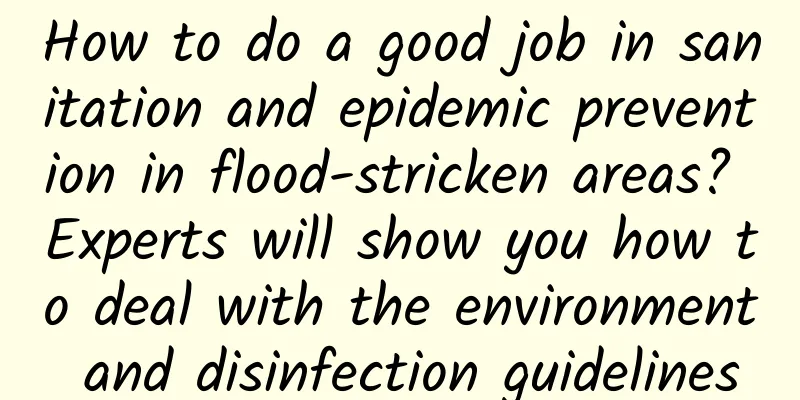How to do a good job in sanitation and epidemic prevention in flood-stricken areas? Experts will show you how to deal with the environment and disinfection guidelines

|
In recent days, extreme rainfall has occurred in North China and Northeast my country, causing floods and geological disasters. The National Center for Disease Control and Prevention has issued the "Guidelines for Environmental Sanitation Treatment and Preventive Disinfection in Flood-stricken Areas (2023 Edition)" to provide guidance for local governments to effectively prevent public health disasters. How can we ensure the safety of drinking water for the people? How can we clean our homes after a flood? The National Center for Disease Control and Prevention recently organized experts to be interviewed by Xinhua Viewpoint reporters to explain the relevant requirements and standards. Map: Hu Ge, Lin Qiujin Water use: Bottled water is preferred for household use, and water containers and water pipes should be fully disinfected Information released by the Health Emergency Center of the Chinese Center for Disease Control and Prevention shows that flood disasters are likely to increase the probability of public health disasters. Floods wash a large amount of human and animal feces, garbage, and animal carcasses into the water, which may cause contamination by pathogenic microorganisms and increase the risk of waterborne and foodborne disease outbreaks. The guidelines clearly state that bottled water should be given priority for household use. If bottled water is unavailable, it should be boiled before drinking. Water storage and water collection containers and water pipes should be thoroughly rinsed and disinfected before use or reactivation. Reporters learned that health departments and disease control agencies in areas severely damaged by floods have organized health supervision teams at all levels to conduct full coverage inspections of contaminated drinking water in the disaster areas. Water conservancy departments are accelerating the repair of damaged water supply facilities and strengthening the monitoring of key risk water quality indicators and temporary emergency water supply guarantees. As of the 5th, Hebei Province has dispatched 111 health supervision teams with more than 450 people to disaster resettlement sites, schools, nursing homes and other crowded places to check the sanitary conditions of drainage wells, toilets and garbage points one by one to prevent water pollution and ensure the safety of drinking water. "People in the disaster-stricken areas should be careful not to drink raw water, water from unknown sources or that is contaminated, and not use water from unknown sources or that is contaminated for gargling, washing vegetables, etc." Pan Lijun, director of the Environmental Health Protection Office of the Institute of Environmental and Health-Related Product Safety of the Chinese Center for Disease Control and Prevention, said that if conditions permit, it is recommended that people give priority to drinking bottled water. If there is no bottled water, it should be completely boiled before drinking. Regarding non-direct drinking water, Shen Jin, director of the Disinfection Center of the Institute of Environmental and Health-Related Product Safety of the Chinese Center for Disease Control and Prevention, reminded that if families use tank (bucket) water or hand-pressed well water, they must disinfect the water. Shen Jin said that if the water is relatively clear, it can be directly disinfected before use. If it is very turbid, it can be disinfected after natural clarification or alum coagulation and precipitation. Commonly used disinfectants are bleaching tablets or chlorine-containing effervescent tablets, with a chlorine dosage of 4 to 8 mg per liter. Clean up the pollution: clean up the silt, garbage and feces in time, and do not eat food soaked by flood water The guidelines clearly state that local governments should formulate targeted work plans based on the disaster situation and the risk of local infectious diseases, and carry out environmental sanitation cleaning and disinfection work in a timely manner. Silt, animal carcasses, garbage and feces should be cleaned up in a timely manner and handled harmlessly. The large amount of garbage generated by pollution control should be removed in a timely manner, and dumping in the river is strictly prohibited. Pan Lijun said that the silt and water left after the flood can easily lead to the breeding of vectors. The affected people should promptly remove the silt and water in the courtyard and living room. If there is a lot of water accumulated in the basement, it needs to be pumped out in batches according to the situation to avoid pumping out all the water in a short time, which may cause structural damage and wall collapse. "Boiling is the first choice for disinfecting tableware and drinking utensils, and the boiling time should be more than 15 minutes." Shen Jin said that the indoor environment and items of personal residences should also be fully disinfected after the disaster. The walls and floors can be sprayed or wiped with a chlorine-containing disinfectant solution with an effective chlorine content of 500 mg per liter. After cleaning, furniture, sanitary ware and other daily necessities should also be rinsed, wiped or soaked with a chlorine-containing disinfectant solution. Experts stressed that people in the disaster area should not eat any food soaked in flood water, and steamed food should be fully heated before eating. At the same time, hand hygiene and personal health monitoring should be strengthened. For example, before meals, after defecation, before breastfeeding, before and after nursing patients, after contact with animals or animal carcasses, etc., you need to wash your hands with soap or hand sanitizer under running water. If you have diarrhea, vomiting, fever or abdominal pain after contact with flood water, you should seek medical attention in time. Disinfection: Choose methods that are safe for humans and animals and environmentally friendly, and avoid excessive disinfection According to the guidelines, staff should understand the usage and precautions of various disinfectants, choose disinfection methods that are reliable, simple, safe for humans and animals, and environmentally friendly as much as possible, and implement disinfection measures correctly. In general, the external environment is mainly cleaned, and disinfection is carried out after cleaning the key areas. Disinfection should not be sprayed on the disaster area environment, traffic roads, pavement, tents, etc. where there is no disinfection indication to prevent excessive disinfection. The reporter learned from the interview that in order to do a good job in disinfection of key areas, the Mentougou District Center for Disease Control and Prevention in Beijing has established 10 epidemic prevention guidance groups to guide the affected areas to do a good job in disinfection of flooded roads, farmers' courtyards, toilets, etc. The Heilongjiang Provincial Center for Disease Control and Prevention issued a flood season health reminder to guide the flood-stricken areas to carry out targeted and timely cleaning and preventive disinfection work. "The resettlement sites for the affected people, hospitals, schools, kindergartens, markets and other places closely related to people's lives and work are the key areas for environmental sanitation and disinfection in the disaster area." Shen Jin reminded that after cleaning and disinfecting these key places, doors and windows should be opened to increase indoor air convection and ventilate in time. When people use cleaning agents and disinfectants, they should carefully read and follow the instructions on the product labels and not mix them. Flooded toilets, livestock breeding sites, etc. should also be fully disinfected. (Reporters Gu Tiancheng, Qin Jing, Xu Kaixin) |
>>: It’s cockroach season again! Why can’t we kill or eradicate these “little cockroaches”?
Recommend
New App Store: From search ranking to download conversion, you need these three yardsticks
It’s the middle of the year again, and it’s time ...
New mobile phones have nearly half the capacity and many pre-installed apps and alarming standby traffic.
A mobile phone with a nominal 8G capacity has onl...
Optimize your information flow by taking these two steps and the effect will increase!
Today, we will use actual cases to further analyz...
The most powerful user psychology analysis: How does "Honor of Kings" make people addicted to it step by step?
Let’s first look at a set of data: " Honor o...
New media operation skills: How to become a blogger with millions of followers?
Although the author is not a top blogger, the num...
Meituan responded to the cancellation of Alipay. Why did Meituan cancel Alipay again?
Meituan responds to cancellation of Alipay July 3...
Seven white marble columns from the Old Summer Palace return home! Is white marble "jade"?
On October 13, the State Administration of Cultur...
Hot search! Many people are looking for oyster sauce in the kitchen these days...
Oyster sauce is one of the indispensable seasonin...
Party Founding Day丨Stay true to your original aspiration and realize your dream! Revisit the original aspirations of old scientists to join the party
There is a group of scientists who have made beco...
The "bouncing pig" that went viral on social networks is actually not a pig! It is now an endangered species, with only a few thousand left in the world
Some time ago, a Thai pygmy hippopotamus named Mo...
Have you ever used the black technology code? The god-like automatic code app
When we share screenshots, we usually block out o...
Is it expensive to develop a fresh food mini program in Fuzhou? A list of the development costs of Fuzhou Fresh Food Mini Program
The main factors affecting the price of mini prog...









